Obrimini
The Obrimini are the most species-rich tribe of the Phasmatodea family of the Heteropterygidae native to Southeast Asia.
| Obrimini | |
|---|---|
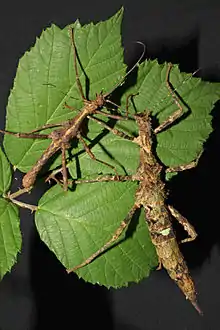 | |
| Pair of Obrimini sp. 'Negros', a species of an undescribed genus | |
| Scientific classification | |
| Domain: | Eukaryota |
| Kingdom: | Animalia |
| Phylum: | Arthropoda |
| Class: | Insecta |
| Order: | Phasmatodea |
| Family: | Heteropterygidae |
| Subfamily: | Obriminae |
| Tribe: | Obrimini Brunner von Wattenwyl, 1893 |
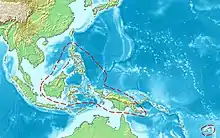 | |
| Range of the Obrimini[2] | |
| Synonyms[3] | |
| |
Description
The Obrimini differ from their sister tribe the Hoplocloniini by the structure of the secondary ovipositor at the abdomen of the females, which surrounds the actual ovipositor. It is formed in the Obrimini dorsally from the eleventh abdominal tergum called supraanal plate or epiproct, while in the Hoplocloniini it originated from the tenth tergum.[2][4][5]
Distribution area
The distribution area of the Obrimini extends from Borneo to the east and includes the Philippines, Sulawesi, most of the Moluccas and New Guinea. Farthest east lies with Viti Levu, the main island of the Fiji group, the distribution area of Pterobrimus depressus.[2][5]
Taxonomy
| |||||||||||||||||||||||||||||||||||||||||||||||||||||||||||||||||||||||||||
| Relationships of the examined Obrimini genera by Sarah Bank et al (2021)[2] |
Brunner von Wattenwyl built in 1893 for the genera already described Obrimus, Hoploclonia, Tisamenus, Pylaemenes, Dares and Datames (today a synonym to Pylaemenes) the tribe Obrimini (abbreviated there as Obrimi.). He placed these together with the genus Heteropteryx and the South American tribe Cladomorphini (abbreviated there as Cladomorphi.) in the family Cladomorphidae (now synonymous with Cladomorphinae).[6] In the following years, basesd on this work, mostly genera of today's Obriminae and Dataminae were listed in this tribe, for example by Josef Redtenbacher in 1906.[4] Lawrence Bruner raised the Obrimini to the rank of a family in 1915. James Abram Garfield Rehn and his son John William Holman Rehn divided the Obriminae, which they only referred to as a subfamily, into the tribes Obrimini and Datamini in 1939.[7] Both tribes were transferred in 1953 by Klaus Günther to the subfamily Heteropteryginae.[8] In 2004 Oliver Zompro raised this subfamily to the rank of family and the tribes contained in the rank of subfamilies or in the rank of a separate family (Anisacanthidae). At the same time he built three tribes in the subfamily Obriminae. In addition to the Obrimini, these were the Miroceramiini and the Eubulidini.[9] The latter was in 2016 by Frank H. Hennemann et al synonymized with the Obrimini. At the same time, the new tribe Tisamenini was established within the Obriminae.[5] In a study based on genetic analysis, published in 2021, Sarah Bank et al synonymized the tribe Miroceramiini and the tribe Tisamenini with the Obrimini and placed next to this the Hoplocloniini as the only other tribe in the subfamily Obriminae. In addition, a species previously referred to as Trachyaretaon sp. 'Negros' was identified as a representative of an as yet undescribed genus.[2]
Genera
| Image | Genus | Species |
|---|---|---|
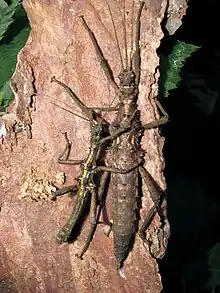 | Aretaon Rehn, J.A.G. & Rehn, J.W.H., 1939 |
|
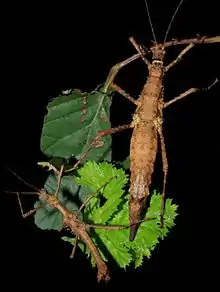 | Brasidas Rehn, J.A.G. & Rehn, J.W.H., 1939 |
|
_female_-_dorsal.jpg.webp) | Eubulides Stål, 1877 |
|
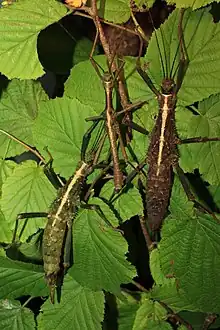 | Euobrimus Rehn, J.A.G. & Rehn, J.W.H., 1939 |
|
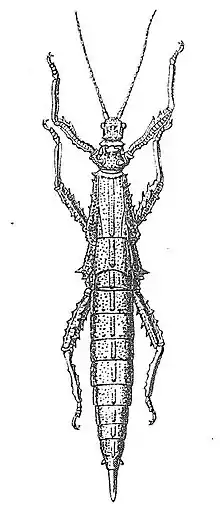 | Heterocopus Redtenbacher, 1906 |
|
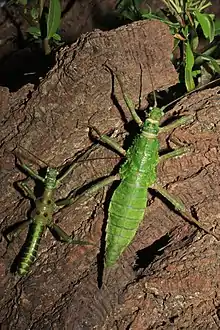 | Mearnsiana Rehn, J.A.G. & Rehn, J.W.H., 1939 |
|
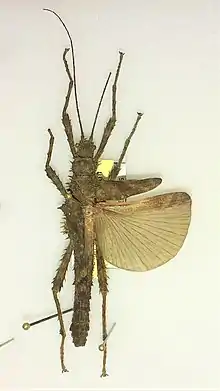 | Miroceramia Günther, 1934 |
|
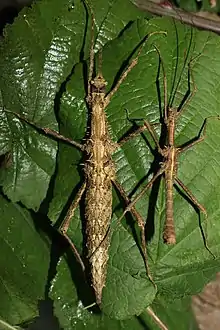 | Obrimus Stål, 1875 |
|
| Pterobrimus Redtenbacher, 1906 |
| |
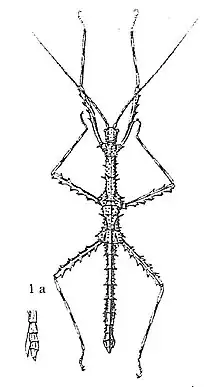 | Stenobrimus Redtenbacher, 1906 |
|
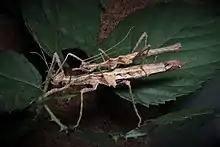 | Sungaya Zompro, 1996 |
|
 | Theramenes Stål, 1875 |
|
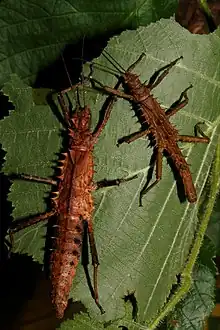 | Tisamenus Stål, 1875 |
|
 | Trachyaretaon Rehn, J.A.G. & Rehn, J.W.H., 1939 |
|
References
- Robertson, J. A.; Bradler, S. & Whiting, M. F. (2018). Evolution of Oviposition Techniques in Stick and Leaf Insects (Phasmatodea), Frontiers in Ecology and Evolution
- Bank, S.; Buckley, T. R.; Büscher, T. H.; Bresseel, J.; Constant, J.; de Haan, M.; Dittmar, D.; Dräger, H.; Kahar, R. S.; Kang, A.; Kneubühler, B.; Langton-Myers, S. & Bradler, S. (2021). Reconstructing the nonadaptive radiation of an ancient lineage of ground-dwelling stick insects (Phasmatodea: Heteropterygidae), Systematic Entomology, DOI: 10.1111/syen.12472
- Brock, P. D.; Büscher, T. H. & Baker, E. W.: Phasmida Species File Online. Version 5.0./5.0 (accessdate 12 June 2023)
- Redtenbacher, J. (1906). Die Insektenfamilie der Phasmiden. Vol. 1. Phasmidae Areolatae. Verlag Wilhelm Engelmann, Leipzig, pp. 45 ff.
- Hennemann, F. H.; Conle, O. V.; Brock, P. D. & Seow-Choen, F. (2016). Revision of the Oriental subfamiliy Heteropteryginae Kirby, 1896, with a re-arrangement of the family Heteropterygidae and the descriptions of five new species of Haaniella Kirby, 1904. (Phasmatodea: Areolatae: Heteropterygidae), Zootaxa 4159 (1), Magnolia Press, Auckland, New Zealand, ISSN 1175-5326
- Brunner von Wattenwyl, C. (1893). Annali del Museo Civico di Storia Naturale Giacomo Doria. Genova (2) 13 (33):101, p. 98
- Rehn, J. A. G. & Rehn, J. W. H. (1939). Proceedings of The Academy of Natural Sciences (Vol. 90, 1938), Philadelphia, pp. 389 ff.
- Günther, K. (1953). Über die taxonomische Gliederung und die geographische Verbreitung der Insektenordnung der Phasmatodea, Beiträge zur Entomologie, Band 3, Nr. 5, pp. 541–563
- Zompro, O. (2004). Revision of the genera of the Areolatae, including the status of Timema and Agathemera (Insecta, Phasmatodea), Goecke & Evers, Keltern-Weiler, pp. 191–240, ISBN 978-3931374396
- Frank H. Hennemann, . H. (2023). Theramenes letiranti – a remarkable new species of Obriminae stick insects from Mindanao, Philippines (Insecta: Phasmatodea: Heteropterygidae), Faunitaxys, 11 (45), pp.1–9
External links
 Data related to Obrimini at Wikispecies
Data related to Obrimini at Wikispecies